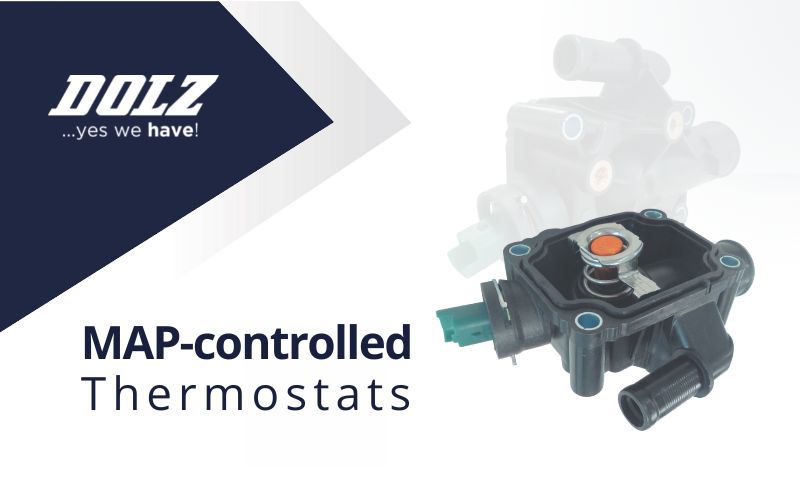The map-controlled thermostat provides an answer to the many dilemmas that automotive manufacturers are currently facing. As engines increase their power, the key function of thermostats in motors’ cooling systems is again highlighted. Additionally, the search for better motor efficiency and less emissions can find a solution in electrically heated thermostats.
As a result, more and more manufacturers are incorporating an electronic thermostat control in their final products, increasing their durability and precision.
Keep reading to find out more about the MAP-controlled thermostat and its main benefits.
Map Controlled vs Conventional temperature regulation
Depending on the application and technology of the combustion engine, thermostats must exhibit different functional characteristics and ways of functioning.
To increase engine efficiency, a new electronically controlled thermostat technology was developed. This type of thermostat can be understood as an improvement on conventional thermostats, characterized by a wider working range.
An electrically controlled thermostat (MAP) works in the same way and has the same mechanical structure as a conventional thermostat, but its main difference is that the map-controlled thermostat also works at a higher engine temperature.
It also complements the conventional regulation of the cooling circuit by means of an electrically controlled integrated heating element that is activated on demand. Consequently, the thermostat can influence the temperature considerably faster.
As such, the result is a higher and more precise influence of the thermostat on engine temperature, which adjusts to particular engine conditions and needs, all while meeting optimum temperature ranges.
All in all, while the function of map-controlled thermostats is the same as conventional thermostats, they provide a series of unmatched benefits:
- Stabilize engines even at higher temperatures.
- Greater and more instant power responses.
- Optimized combustions, regardless of coolant temperatures.
- Minimized emissions and pollution, thanks to better combustions.
- Less fuel consumptions, as engine viscosity is reduced and so are frictional losses.
- Enhanced interior heating in cars and higher user comfort.
This improved regulation of the cooling system helps manufacturers meet increasing pressures to minimize pollution and increase engine efficiencies.
Related content: Official unboxing of the new Dolz’s automotive thermostats
How a map-controlled thermostat works
(MAP) Controlled Thermostats are controlled by the engine’s electronic control unit (ECU).
Traditional versions incorporated a wax component to act as an expansion and heating element. When temperatures rise, this wax component increases its size and starts a moving system where pistons are in charge of increasing flow volumes in the coolant liquid. What map-controlled thermostats do is integrate an electrical interface and heating coil in the equation, which are in charge of connecting the expansion element to the heating.
During standard operations, the map controlled thermostat works the same way as conventional ones, only they allow higher engine temperatures.
Additionally, when sensors detect an expanded need based on the engine’s loads, the thermostat opens accordingly. This can happen when the control system for the powertrain detects a higher engine load, a faster vehicle speed or the activation of the sport mode. In that case, the wax element will quickly open up the thermostat to its maximum position thanks to heating, and coolant temperatures will be able to be lowered.
Thus, while map-controlled thermostats also employ expanding wax, they are able to better control the temperature of said wax, doing so in a faster manner. The result is an engine that performs efficiently at multiple load and operating conditions.
Advantages of map-controlled thermostats in the aftermarket
The main benefit of this type of thermostat is the ability to open the thermostat before the coolant reaches too high an operating temperature. To do this, the engine’s control unit will activate it before the coolant reaches a certain temperature. This fact becomes very useful when the vehicle is under certain conditions, such as the sport mode.
Map-controlled thermostats not only generate less pollution and greater engine efficiencies: they’re also extremely durable, they don’t present natural wear and perform without required service or maintenance. In other words, they can last for the entire service life of an engine.
However, improper practices or factors such as the use of low-quality coolant can cause damage to the part. At Dolz we remember the importance of the cooling system and we always recommend when replacing the water pump or bleeding the cooling system to check all the components that are part of the system. Following these simple guidelines for cooling system maintenance will prevent engine overheating and possible future breakdowns.
Keep reading: Thermostat: Discover its key elements
DOLZ thermostats for a perfect temperature and flow
As the independent aftermarket industry evolves and navigates increasingly complex conditions and requirements, the challenge to find a suitable manufacturer and supplier is more important than ever.
At Industrias Dolz we work with the firm commitment to guarantee the supply of high-quality spare parts for both transmission and the vehicle’s cooling, including the electronically controlled thermostat.
Highlighting our products for:
- Use of premium materials that improve durability and reduce maintenance needs.
- Quality production processes and in-house production …All in Dolz.
- A constant investment in innovation through our dedicated R&D department.
- Decades-long experience in the aftermarket sector. Manufacturing since 1934
For further information on any of our product lines, receive commercial information or technical product specifications (including assembly notes), CLICK HERE.


